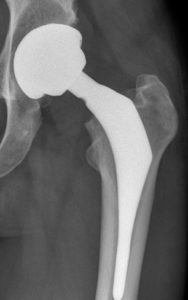
Custom-made hip replacements
A ‘custom-made’ hip replacement sounds amazing. An implant specifically designed for you personally, surely that must be best? In specific cases, this is the case. There are huge number of different hip replacement designs available, and that is one of the reasons why I use a range of different implants, as not one fits all. Therefore, however, the majority of patients do not need a custom-made implant, as there is likely a ‘standard’ option to fit them. This has many advantages. Each implant design has many different options and sizes, and although we tend to know almost exactly what we are going to use before surgery, now and again we need to use one size up, or one size down from the original planned. If we only have one ‘custom-made’ implant, and is a little too big, or a little too small, you are a bit stuck. This rarely happens, but it is a risk. We also know how implants behave and what their survivorship is. This means we can usually confidently tell you how long they are likely to last which is much harder when it is a ‘one-off’ design.
However, there are scenarios where patients may need a custom-made implant. Generally, this is when the patient has very unusual anatomy, where nothing ‘off the shelf’ is going to fit. Often those patients are born with hip problems and may have had a lot of surgery as a baby or a child to try and correct it. This can lead to distorted anatomy and therefore may well need a custom-made implant. In this scenario, they are very helpful and can make complex surgery much easier and less complicated.
Intra-operative navigation and robotics
There has been a huge shift in medicine and surgery towards robotics and augmented reality. This is mainly in its infancy, however, there are definitely benefits with them, as long as you know what you are doing. Unfortunately, nothing is fool proof! The main drive in the NHS is actually not to gain the top few percent, but actually to lift the bottom bar for those surgeons that may not necessarily have the best results, or those who are not so experienced, have more help and input into ‘getting it right first time’. However, this technology is expensive and conversely is really only available to the ‘higher volume’ surgeons who probably need it the least!
But who wouldn’t want the best chance of a great result? I have three options available, which I sure, as I write, is the most of any surgeon.
Mako robot
The Mako robotic arm system is probably the most well known. This is an excellent way of helping the surgeon achieve optimal cup positioning, and the pre-op CT based planning is very helpful regarding implant sizing and placement. The downside of Mako is that it is owned by Stryker, and therefore you can only use their implants. Stryker no longer have ceramic-on-ceramic bearings, as they were the company which had the most problem with post-operative ceramic ‘squeaking’. They also do not have very bone conserving stem designs, however, not all patients are suitable for this. Some of the claims made by the company regarding it are simply not true either, such as saying that it is ‘soft tissue sparing’ has ‘faster recovery’ and ‘less blood loss’. This is down to the surgical technique, not the implant placement, which is where the Mako excels. I therefore do use the Mako system, but it is not suitable for everyone because of the implants choices currently available.
Naviswiss
The most recent addition to the market is the ‘Naviswiss’ system (currently marketed by JRI). This is purely an intra-operative navigation system and does not require anything more than an x-ray for pre-operative planning. This is good as there is less lead time to surgery, as there are no CT scans that need processing or patient specific instrumentation to be manufactured. This however, Naviswiss on its own doesn’t make allowances for individual biomechanical variances and relies on the surgeon’s judgement regarding what the best cup position is (it does measure it for you, though). It also measures leg length and offset (the distance between the femur and pelvis), so is a very useful tool to help the surgeon get the implant positioning correct, especially the femoral side.
Optimised Positioning System (OPS)
What I have been using for some years now is the Optimised Positioning System (OPS). This is technology that originated in Australia but was bought by Corin, and therefore excusive to them (like the Mako to Stryker). Corin do have a much broader implant portfolio (with some more bone conserving stems) and also have both ceramic-on-ceramic and ceramic-on-polyethylene options. OPS was the first commercially available system which aimed to consider each individuals personal biomechanics and therefore make allowances for it. This flies in the face of some of the original teaching of exactly the same implant position for every patient, which had been the ‘holy grail’ for some time and what the Mako originally was designed for.
Get Moving Again
Helping you get back to an active lifestyle
RECOGNISED BY ALL THE MAJOR INSURERS


